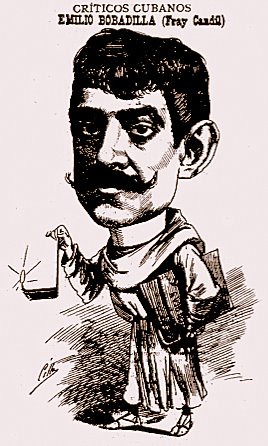3.7.13 The literary criticism of Emilio Bobadilla (1862 – 1921), “Fray Candil”

So-called satirical criticism had its main exponent on the island, Emilio Bobadilla, along with Aniceto Valdivia. He devoted himself more to the practice of literary criticism itself than to theorizing about it. In fact, his works lack a solid theoretical conception to support the opinions he expressed, which were generally incisive and tended to detect errors and shortcomings, like stains in the light, rather than offering a general assessment of the texts.
Bobadilla professed separatist ideas that led him to leave the island and travel extensively throughout Europe and America, in line with the most repressive colonial circumstances. In Europe, he became imbued with positivist principles, and in Spain, particularly, he came into contact with burlesque criticism, which he would imitate in much of his work.
Within this, the texts that had the greatest significance, despite the arbitrary nature of his judgments, were: “Reflejos de Fray Candil” (Reflections of Fray Candil), from 1886, “Escaramuzas” (Skirmishes), from 1888, “Capirotazos” (Skirmishes), from 1890, “Triquitraque” (Triquitraque), from 1892, “Solfeo” (Solfeo), from 193, and “Baturrillos” (Baturrillos), from 1895, where he displays an erudition that is not truly profound and attacks pieces by numerous authors.
One of his most superficially satirical writings was the one he conceived as an excessive response to a criticism made by Enrique José Varona of his book “Reflejos de Fray Candil.” The text was titled “Varona… o a lo que salga” (Varona… or whatever comes out of it), and he went so far as to describe Varona as a “goggle-wearing, cane-wielding schoolteacher.” Manuel de la Cruz and Manuel Sanguily defended Varona, both measured but still pointing out Bobadilla’s unhealthy audacity and his lack of sobriety in analyzing the texts.
Later he would return to the figure of Varona, commissioned by critic José del Perojo, for the magazine “Nuevo Mundo”, this time recognizing some of his virtues but without failing to risk certain biting phrases.
He took his sarcastic attitude to the extreme of referring harshly to the works of Spaniards Leopoldo Alas and Emilia Pardo Bazán, who had helped him enter the literary spheres of Spanish society. Despite these biases, a more in-depth study of his work remains to be done to determine his merits.
Few were the authors who escaped his condemnatory judgments, among the chosen ones was Juan Clemente Zenea, to whom he even dedicated some verses of elegiac tone in 1897, focused above all on the tragedy of the bard’s death but where he inserts some assessment of his poetics:
“You were young and an artist,
And your soldier judges
Merciless, ingenuity-less and backward,
The liver pregnant with resentments,
And among your compatriots, who had
That like you he cried for his pains
In verses of such deep poetry?








